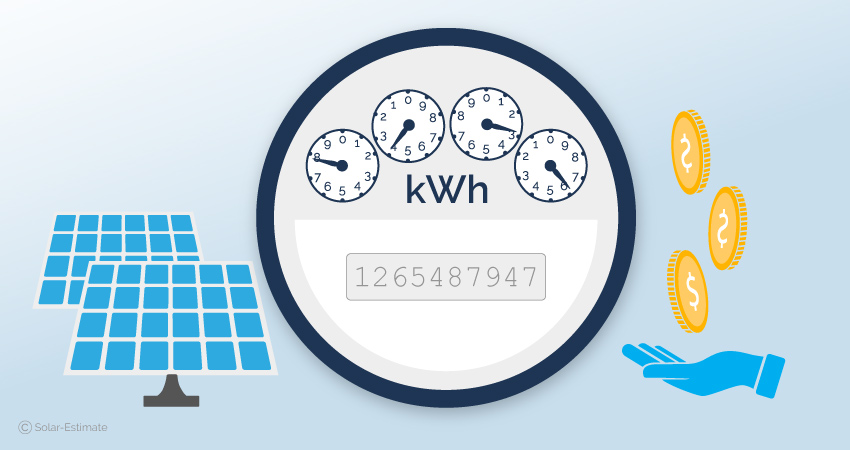How much do FPL net metering rates pay for excess solar power exported to the grid?
Written by Andrew Sendy
Updated August 12, 2021
5 minutes read
Categories: Net metering, Solar 101, Solar efficiency, Solar energy, Solar panels, Solar power

According to the National Association of Homebuilders, as of 2013, the average electricity bill costs homeowners $110 per month, making it the most expensive utility. Imagine being able to save on your energy bill – or better yet, have the electric company pay you for electricity. Homeowners that have invested in solar systems experience just that.
A net metering program is a system power companies use to help people with solar energy offset the cost of their electricity. Their system is tied to the grid, and when they have surplus energy, it goes into the grid – and the power company credits them for it.
In months where there isn’t as much energy produced by the solar panels, homeowners can use a combination of solar energy and grid electricity, which still keeps monthly electric bill costs down. For some, the average electricity produced by their solar system for the calendar year ends up offsetting the cost of electricity completely.
What are FPL net metering rates?
FPL stands for Florida Power & Light Company. They are the third-largest company in the nation and have an excellent reputation for affordability and reliability. Not only do they provide an admirable amount of jobs, but have placed a huge focus on sustainable energy.
The net metering program at FPL is well thought out, and easy for homeowners to utilize. Once your application is approved in your appropriate tier, you will receive a net metering rate that is valued at the rate you would pay for your next kWh. This is what the FPL website says:
“The energy you produce and consume offsets the energy you would normally purchase from FPL, and it is valued at the amount you would pay for your next kWh. The cost varies with individual usage patterns, and you should refer to your previous electric bills to determine the appropriate value. If you produce enough electricity that you have a surplus at the end of the year, FPL will apply a credit to your January bill based on the average annual cost of generation.”
Customers will be able to look at each bill to find out how much energy they used, and how much credit they have or if a payment is due. Credit rolls over each month and any annual surplus credit are rolled over into January of the next year as a cash credit that is applied to your January bill.
You won’t be able to see an entire amount of energy your system produced on your bill since the FPL meter won’t “read” the amount your home uses each month, however, that information is available on your inverter. Plus, you will be able to see on your bill how much “extra” energy your system provided to the grid.
What power sources are eligible for net metering with FPL?
Solar energy is not the only sustainable energy eligible for net metering with FPL. Other sources include:
- Wind energy
- Biomass
- Geothermal energy
- Hydroelectric power
- Ocean energy
- Waste heat
- Hydrogen
Is net metering an automated service?
You are not automatically enrolled in the FPL net metering program once you have a new sustainable energy system installed. You must first meet the requirements and fill out an application. Once you are approved, the process becomes automated; meaning the company will automatically factor in your system’s energy production, and how much energy you use from FPL.
If you are getting a system specifically to use with the FPL net metering program, make sure you are familiar with the guidelines and regulations.
What are the steps to apply for the FPL net metering program?
Begin the process by reading up on FPL’s net metering FAQs. Next, follow these steps:
- Select your tier (1, 2, or 3). Most residential customers will be Tier 1.
- Apply using your account number, SSN or EIN, and equipment size and details
- After pre-approval, you’ll have to sign the interconnection agreement
- When the system is installed, you will have to get it inspected and upload a copy of the approved permit
- FPL requires the following documents: Inspection sign off, description of work (for example, solar panels), address where the system was installed, permit number, building department name
- Once everything is approved by FPL, a bi-directional meter will be installed (do not use parallel operation until it is)
- After the new bi-directional meter is in, wait for FPL email that requests your permission to operate your new installation
Professional solar system installers in Florida will be able to help with the application process.
Key takeaways for FPL’s net metering program
All of the information on net metering is available on FPL’s site. However, it’s helpful to know that the net metering rate you’ll receive is the same as what you pay for electricity from FPL, which was an average of 10.8 cents per kWh as of June 2017. Surplus energy from your system will show on your bill as a credit. Surplus credits for a calendar year will become cash credits that are applied to your January bill. To utilize net metering, you must have a bi-directional meter.
If you live in Florida, make sure you take all the appropriate steps to become interconnected with FPL and enjoy the rewards of investing in sustainable energy.
